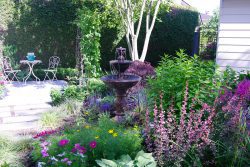As the summer is about to roll into Metro Vancouver we are hearing that many of our clients are embracing the idea of a staycation this year. If you’re thinking the same, why not consider transforming your outdoor space into a personal sanctuary? A Zen or therapeutic garden is the perfect staycation project; it’s an opportunity to create a space of calm, healing, and natural beauty right in your own backyard. Whether you live in Vancouver, Burnaby, Richmond, or the North Shore, this guide will walk you through creating a tranquil retreat that’s perfectly suited to our local West Coast climate.
What Is a Zen or Therapeutic Garden?
A Zen garden, also called a karesansui, is a minimalist Japanese-inspired space often featuring sand or gravel, stones, and carefully selected greenery. It encourages quiet reflection and mindfulness. Unlike Western gardens filled with vibrant blooms and dense foliage, a traditional Zen garden uses natural, minimalist elements. A Zen garden is not meant to be walked through, but rather viewed and contemplated, much like a living piece of art. However, modern adaptations typically include small paths or seating areas to suit personal use.
A therapeutic garden is designed to promote healing and stress relief, using plants, textures, scents, and sounds to engage the senses and soothe the mind. These gardens are especially helpful for mental wellness, recovery, and aging in place. These spaces have roots in both horticulture therapy and evidence-based design, and they’re often used in hospitals, senior living communities, and wellness centres. But more and more people are creating them at home for stress relief, gentle exercise, and mindful connection with nature.
Metro Vancouver’s Climate: What to Know Before You Start
Metro Vancouver is in Hardiness Zone 8b, which means:
- Winters are mild (usually no frost beyond December–January).
- Summers are dry (watering and mulching are important).
- Rainfall is abundant in fall, winter, and spring.
- Shade and moisture tolerance are important for some garden areas.
So when choosing plants or materials, it’s best to pick drought-tolerant species for sunny spots, and moisture-loving, shade-tolerant ones for those classic soggy corners.
How to Build Your Zen or Therapeutic Garden
Step 1. Choose Your Space Wisely
Whether you have a large backyard or a small patio, you can make it become a haven.
The key is to look for:
- Quiet corners
- Natural sunlight or partial shade (this will affect your plant choices)
- Good drainage, especially in our rainy climate.
Tip: Use trellises, bamboo fencing, or tall grasses to carve out privacy.

Step 2. Design Your Layout Based on Function
Before you buy a single stone or shrub, ask yourself:
- Is this for meditation and reflection?
- Do I want to use it for reading, yoga, or tea time?
- Will it be a hands-on gardening space for sensory therapy?
From there, decide if you’ll include features like a raised herb bed, a walking path, or a small water feature.
Step 3. Hardscape First: Paths, Fences, and Structures
Zen Garden Must-Haves:
- Raked gravel or sand area – Use crushed granite or light-coloured pea gravel.
- Large stones or driftwood – Driftwood from local beaches adds a West Coast vibe.
- Stepping stones – Natural slate or river rock paths complement our rainy climate (look for non-slip surfaces).
Therapeutic Garden Must-Haves:
- Raised beds or containers – Cedar planters are long-lasting in our damp winters.
- Water feature – A plug-in fountain or solar-powered gurgler adds sound therapy.
- Seating area – Use weather-resistant benches or adirondack chairs in shaded corners.

Step 4. Select Climate-Appropriate Plants for Zone 8b
We’ve curated a list of plants that thrive in therapeutic and Zen gardens.
Zen Garden Plants (for the minimalist and structural goal)
- Mondo grass – Compact and grass-like.
- Dwarf conifers – Like dwarf Mugo Pine.
- Bamboo – Clumping, non-invasive, best planted in containers.
- Mosses – Ideal for shady, wetter corners.
Therapeutic Garden Plants (for sensory and healing vibes)
Sight & Texture:
- Lamb’s ear – Soft, fuzzy leaves.
- Heuchera – Colourful foliage and pollinator-friendly.
Scent:
- Lavender – Compact, fragrant, and drought-tolerant.
- Thyme – Creeping and aromatic, also edible.
- Daphne odora – Lovely fragrance in early spring.
Taste & Healing:
- Chamomile – Calming teas.
- Mint – Best in containers as it spreads!
- Calendula – Bright and useful in skin salves.
Shade-Friendly Options:
- Ferns – Iconic West Coast look.
- Hostas – Textured leaves and shade-loving.
- Astilbe – Feathery flowers for wet shaded areas.

Step 5. Add the Finishing Touches
- Lighting – Try soft solar lanterns or string lights.
- Sound – Wind chimes or a gurgler fountain.
- Art – Ceramic pieces from your local garden centre, Buddha statues, or driftwood accents.
Step 6. Watering and Maintenance
Our dry summers mean deep watering is a must. Make sure to follow Metro Vancouver’s watering restrictions bylaw.
You can use:
- Soaker hoses or drip irrigation systems
- Mulch to retain moisture and suppress weeds
- Rain barrels (check for rebates with your local municipality)
Maintenance Tip: Raking gravel, pruning, and harvesting herbs can all be part of your mindful gardening routine.
Final Thoughts – Your Backyard, Reimagined
With a little intention, your outdoor space can become a restorative retreat that rivals even the best spa resort. A Zen or therapeutic garden designed for our unique climate not only improves your well-being, it also adds lasting value to your home. So light that citronella candle, brew some mint tea from your own garden, and enjoy your staycation in the sanctuary you’ve created!

Comments are closed here.